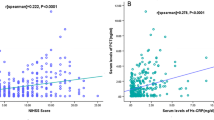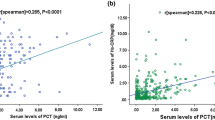Abstract
Objective
To detect the serum procalcitonin (PCT) level and determine its relationship with the infarct volume in young patients with acute cerebral infarction.
Methods
According to the infarct volume, young patients with acute cerebral infarction were divided into large group, intermediate group, and small group. The severity of clinical symptoms was determined according to the National Institute of Health Stroke Scale (NIHSS) score. Healthy young people were selected as the control group. Serum PCT levels were measured. The relationship among PCT, volume, and NIHSS score was analyzed.
Results
PCT in observation group was significantly higher than that in control group (t = 6.879, P = 0.011), and PCT in severe group was significantly higher than in mild group (t = 6.978, P = 0.016). PCT in large cerebral infarction group was higher than that in intermediate and small-size infarct group (P = 0.0036 and P < 0.0001, respectively), and PCT in intermediate cerebral infarction group was higher than that in small-size infarct group (P = 0.0024). In observation group, the PCT level was positively correlated with both NIHSS (r = 0.793, P = 0.022) and infarction volume (r = 0.649, P = 0.007).
Conclusion
The level of PCT in young patients with acute cerebral infarction may be related to the inflammatory reaction of the cerebral artery and positively related to the volume of cerebral infarction and NIHSS score. To some extent, PCT concentration can predict the disease severity of acute cerebral infarction.


Similar content being viewed by others
Data availability
All data are available and stored by the authors.
Abbreviations
- PCT:
-
Procalcitonin
- NIHSS:
-
National Institute of Health Stroke Scale
- DWI:
-
Diffusion-weighted imaging
- BMI:
-
Body mass index
- ELISA:
-
Enzyme-linked immunosorbent assay
- EDTA:
-
Ethylenediaminetetraacetic acid
- AIS:
-
Acute ischemic stroke
- LCI:
-
Large cerebral infarction
References
Schindler A, Schinner R, Altaf N, Hosseini AA, Simpson RJ, Esposito-Bauer L, Singh N, Kwee RM, Kurosaki Y, Yamagata S (2020) Prediction of stroke risk by detection of hemorrhage in carotid plaques: meta-analysis of individual patient data. JACC Cardiovasc Imaging 13(2 Part 1):395–406
Cuenca-Lopez MD, Brea D, Segura T, Galindo MF, Anton-Martinez D, Agulla J, Castillo J, Jordan J (2010) Inflammation as a therapeutic agent in cerebral infarction: cellular inflammatory response and inflammatory mediators. Rev Neurol 50(6):349–359
Badacz R, Przewłocki T, Gacoń J, Stępień E, Enguita FJ, Karch I, Żmudka K, Kabłak-Ziembicka A (2018) Circulating miRNA levels differ with respect to carotid plaque characteristics and symptom occurrence in patients with carotid artery stenosis and provide information on future cardiovascular events. Postępy Kardiol Interwencyjnej 14(1):75
Ertem AG, Efe TH, Yayla Ç, Akboğa MK, Açar B, Ünal S, Kirbaş Ö, Sezer Tekce Y, Maden O, Selcuk H (2017) The association between serum procalcitonin levels and severity of coronary artery disease assessed by SYNTAX score in patients with acute coronary syndrome. Angiology 68(1):40–45
Gilbert DN (2020) Neglected variables in the interpretation of serum procalcitonin levels in patients with septic shock. J Infect Dis 222((Supplement_2)):S96–S102
Zhang Y, Chen Z, Tang Y, Shan W, Wang L, Shi J, Luo Q, Duan J, Xu G (2018) Association between procalcitonin levels and carotid atherosclerosis in acute ischemic stroke patients. Int J Neurosci 128(3):237–242
Deng W-J, Shen R-L, Li M, Teng J-F (2015) Relationship between procalcitonin serum levels and functional outcome in stroke patients. Cell Mol Neurobiol 35(3):355–361
Bian Z (2015) Risk factors of cerebral infarction in young people [in chinese]. Shandong Med 21:67–68
Association NboCM (2015) Guidelines for the diagnosis and treatment of acute ischemic stroke in China 2014. Chin J Neurol [Chinese] 48:246–257
Kwah LK, Diong J (2014) National Institutes of Health Stroke Scale (NIHSS). J Physiother 60(1):61. https://doi.org/10.1016/j.jphys.2013.12.012
Pantoni L (2010) Cerebral small vessel disease: from pathogenesis and clinical characteristics to therapeutic challenges. Lancet Neurol 9(7):689–701
Revised Committee of Chinese Guidelines for the Prevention and Treatment of Hypertension (2011) Chinese Guidelines for the Prevention and Treatment of Hypertension 2010. Chin J Hypertens 8:701–743
(2011) Diabetes Branch of Chinese Medical Association Guidelines for the Prevention and Treatment of Type 2 Diabetes in China (2010 Edition). Chin J Front Med (Electron Ed) 3(6):54–109
Zhu J, Gao R, Zhao S et al (2016) Guidelines for the prevention and treatment of dyslipidemia in Chinese adults (revised edition 2016). China Circ Mag 31(10):937–953
Kim JM, Park KY, Shin DW, Park MS, Kwon OS (2016) Relation of serum homocysteine levels to cerebral artery calcification and atherosclerosis. Atherosclerosis 254:200–204. https://doi.org/10.1016/j.atherosclerosis.2016.10.023
Kawle AP, Nayak AR, Lande NH, Kabra DP, Chandak NH, Badar SR, Raje DV, Taori GM, Daginawala HF, Kashyap RS (2015) Comparative evaluation of risk factors, outcome and biomarker levels in young and old acute ischemic stroke patients. Ann Neurosci 22(2):70–77. https://doi.org/10.5214/ans.0972.7531.220204
Renna R, Pilato F, Profice P, Della Marca G, Broccolini A, Morosetti R, Frisullo G, Rossi E, De Stefano V, Di Lazzaro V (2014) Risk factor and etiology analysis of ischemic stroke in young adult patients. J Stroke Cerebrovasc Dis 23(3):e221–e227. https://doi.org/10.1016/j.jstrokecerebrovasdis.2013.10.008
González-Gómez FJ, Pérez-Torre P, DeFelipe A, Vera R, Matute C, Cruz-Culebras A, Álvarez-Velasco R, Masjuan J (2016) Stroke in young adults: incidence rate, risk factors, treatment and prognosis. Rev Clin Esp 216(7):345–351. https://doi.org/10.1016/j.rce.2016.05.008
Li F, Yang L, Yang R, Xu W, F-p C, Li N, J-b Z (2017) Ischemic stroke in young adults of Northern China: characteristics and risk factors for recurrence. Eur Neurol 77(3-4):115–122
Wang W, Jiang B, Sun H, Ru X, Sun D, Wang L, Wang L, Jiang Y, Li Y, Wang Y (2017) Prevalence, incidence, and mortality of stroke in China: results from a nationwide population-based survey of 480 687 adults. Circulation 135(8):759–771
Smajlović D (2015) Strokes in young adults: epidemiology and prevention. Vasc Health Risk Manag 11:157
Ojha R, Huang D, An H, Liu R, Du C, Shen N, Tu Z, Li Y (2015) Distribution of ischemic infarction and stenosis of intra-and extracranial arteries in young Chinese patients with ischemic stroke. BMC Cardiovasc Disord 15(1):158
Park TH, Ko Y, Lee SJ, Lee KB, Lee J, Han M-K, Park J-M, Cho Y-J, Hong K-S, Kim D-H (2015) Identifying target risk factors using population attributable risks of ischemic stroke by age and sex. J Stroke 17(3):302–311
Sarecka-Hujar B, Kopyta I (2020) Risk factors for recurrent arterial ischemic stroke in children and young adults. Brain Sci 10(1):24
Putaala J (2020) Ischemic stroke in young adults. CONTINUUM: Lifelong Learn Neurol 26(2):386–414
Adams HP Jr, Bendixen BH, Kappelle LJ, Biller J, Love BB, Gordon DL, Marsh E 3rd (1993) Classification of subtype of acute ischemic stroke. Definitions for use in a multicenter clinical trial. TOAST. Trial of Org 10172 in Acute Stroke Treatment. Stroke 24(1):35–41
Sloan MA, Kittner S, Feeser B, Gardner J, Epstein A, Wozniak M, Wityk R, Stern B, Price T, Macko R (1998) Illicit drug-associated ischemic stroke in the Baltimore-Washington Young Stroke Study. Neurology 50(6):1688–1693
Michaud M, Mauhin W, Belmatoug N, Garnotel R, Bedreddine N, Catros F, Ancellin S, Lidove O, Gaches F (2020) When and how to diagnose fabry disease in clinical pratice. Am J Med Sci. https://doi.org/10.1016/j.amjms.2020.07.011
van Dongen MME, Aarnio K, Martinez-Majander N, Pirinen J, Sinisalo J, Lehto M, Kaste M, Tatlisumak T, de Leeuw F-E, Putaala J (2019) Use of statins after ischemic stroke in young adults and its association with long-term outcome. Stroke 50(12):3385–3392
Faber JE, Moore SM, Lucitti JL, Aghajanian A, Zhang H (2017) Sex differences in the cerebral collateral circulation. Transl Stroke Res 8(3):273–283
Eltoft A, Arntzen KA, Wilsgaard T, Hansen JB, Mathiesen EB, Johnsen SH (2018) Joint effect of carotid plaque and C-reactive protein on first-ever ischemic stroke and myocardial infarction? J Am Heart Assoc 7(11):e008951
Gupta A, Kesavabhotla K, Baradaran H, Kamel H, Pandya A, Giambrone AE, Wright D, Pain KJ, Mtui EE, Suri JS (2015) Plaque echolucency and stroke risk in asymptomatic carotid stenosis: a systematic review and meta-analysis. Stroke 46(1):91–97
Khan MM, Motto DG, Lentz SR, Chauhan AK (2012) ADAMTS13 reduces VWF-mediated acute inflammation following focal cerebral ischemia in mice. J Thromb Haemost 10(8):1665–1671
Jenny NS, Callas PW, Judd SE, McClure LA, Kissela B, Zakai NA, Cushman M (2019) Inflammatory cytokines and ischemic stroke risk: the REGARDS cohort. Neurology 92(20):e2375–e2384
Ryou MG, Mallet RT (2018) An In Vitro Oxygen-Glucose Deprivation Model for Studying Ischemia-Reperfusion Injury of Neuronal Cells. Methods Mol Biol 1717:229–235. https://doi.org/10.1007/978-1-4939-7526-6_18
Shichita T, Ito M, Yoshimura A (2014) Post-ischemic inflammation regulates neural damage and protection. Front Cell Neurosci 8:319
Alwi I (2020) Targeting inflammation and immune system in acute myocardial infarction. Acta Med Indones 51(4):287
Tobin MK, Bonds JA, Minshall RD, Pelligrino DA, Testai FD, Lazarov O (2014) Neurogenesis and inflammation after ischemic stroke: what is known and where we go from here. J Cereb Blood Flow Metab 34(10):1573–1584
Yan L, Wang S, Xu L, Zhang Z, Liao P (2020) Procalcitonin as a prognostic marker of patients with acute ischemic stroke. J Clin Lab Anal 34(7):e23301. https://doi.org/10.1002/jcla.23301
Dymicka-Piekarska V, Wasiluk A (2015) Procalcitonin (PCT), contemporary indicator of infection and inflammation. Postepy Hig Med Dosw (Online) 69:723–728
Lo SHS, Chang AM, Chau JPC (2017) Establishing equivalence of a Chinese version of the stroke specific quality of life measure for stroke survivors. Disabil Rehabil 39(11):1079–1086
Abdelrasoul AA, Elsebaie NA, Gamaleldin OA, Khalifa MH, Razek AAKA (2019) Imaging of brain infarctions: beyond the usual territories. J Comput Assist Tomogr 43(3):443–451
Abdel Razek AAK, Alvarez H, Bagg S, Refaat S, Castillo M (2014) Imaging spectrum of CNS vasculitis. Radiographics 34(4):873–894
Author information
Authors and Affiliations
Contributions
Huijun Wen designed and implemented the experiment, collected and processed the data, and wrote the first draft of the thesis, and Maikou Lv improved the experiment and revised the thesis.
Corresponding author
Ethics declarations
Conflicts of interest
The authors declare that they have no conflict of interest.
Ethical statement
This study was performed in line with the principles of the Declaration of Helsinki. The research protocol was approved by the Ethical Committee of the Baoji Municipal Central Hospital, China.
Consent to participate
Informed consent was obtained from all individual participants included in the study.
Consent for publication
Informed consent has been obtained from the patient to use the information in this paper for publication.
Additional information
Publisher’s note
Springer Nature remains neutral with regard to jurisdictional claims in published maps and institutional affiliations.
Rights and permissions
About this article
Cite this article
Wen, H., Lv, M. Correlation analysis between serum procalcitonin and infarct volume in young patients with acute cerebral infarction. Neurol Sci 42, 3189–3196 (2021). https://doi.org/10.1007/s10072-020-04856-x
Received:
Accepted:
Published:
Issue Date:
DOI: https://doi.org/10.1007/s10072-020-04856-x




